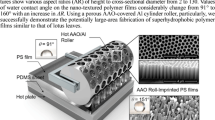Abstract
In this work, we utilized underside of four different plant leaves with different scale of hierarchical surface roughness to fabricate large area self-cleaning antireflective polymer surfaces. A simple and precise two-step soft-lithography replica molding technique was deployed by using polydimethylsiloxane (PDMS) polymer as a replicating material. In the first step, a negative PDMS replica was fabricated by using the underside of an original leaf as a template material. In the second step, a positive PDMS replica was fabricated through a negative PDMS replica used as a template. In order to study the non-wetting and light trapping properties, as-replicated polymer surfaces were characterized using Scanning Electron Microscopy (SEM), contact angle goniometer, and UV-Vis spectroscopy. SEM images confirmed the successful replication of complex hierarchical structures while contact angle measurement studies established retaining high non-wetting properties in polymer replicas. Optical studies suggest near zero reflection in normal mode and less than 5% diffuse reflection when measured using integrated sphere mode. These results have been correlated and explained with the air-liquid fraction and roughness factor as measured using three-dimensional optical profilometer.
Similar content being viewed by others
References
Rahman M M, Islam M A, Karim A Z, Ronee A H. Effects of natural dust on the performance of PV panels in Bangladesh. International Journal of Modern Education and Computer Science, 2012, 4, 26.
Sulaiman S A, Hussain H H, Leh N, Razali M S. Effects of dust on the performance of PV panels. World Academy of Science, Engineering and Technology, 2011, 58, 588–593.
Ali K, Khan S A, Jafri M M. Effect of double layer (SiO2/TiO2) anti-reflective coating on silicon solar cells. International Journal of Electrochemical Science, 2014, 9, 7865–7874.
Neamen D A. An introduction to Semiconductor Devices, McGraw-Hill Higher Education, Boston, USA, 2006.
Bahrami A, Mohammadnejad S, Abkenar N J, Soleimaninezhad S. Optimized single and double layer antireflection coatings for GaAs solar cells. International Journal of Renewable Energy Research (IJRER), 2013, 3, 79–83.
Bernhard C, Miller W H. A corneal nipple pattern in insect compound eyes. Acta Physiologica Scandinavica, 1962, 56, 385–386.
Nakata K, Sakai M, Ochiai T, Murakami T, Takagi K, Fujishima A. Antireflection and self-cleaning properties of a moth-eye-like surface coated with TiO2 particles. Langmuir, 2011, 27, 3275–3278.
Li Y, Zhang J, Zhu S, Dong H, Jia F, Wang Z, Tang Y, Zhang L, Zhang S, Yang B. Bioinspired silica surfaces with near-infrared improved transmittance and superhydrophobicity by colloidal lithography. Langmuir, 2010, 26, 9842–9847.
Chen Y-C, Huang Z-S, Yang H. Cicada-wing-inspired self-cleaningantireflection coatings on polymer substrates. ACS Applied Materials & Interfaces, 2015, 7, 25495–25505.
Niu S, Li B, Mu Z, Yang M, Zhang J, Han Z, Ren L. Excellent structure-based multifunction of morpho butterfly wings: A review. Journal of Bionic Engineering, 2015, 12, 170–189.
Liu Y, Song Y, Niu S, Zhang Y, Han Z, Ren L. Integrated super-hydrophobic and antireflective PDMS bio-templated from nano-conical structures of cicada wings. RSC Advances, 2016, 6, 108974–108980.
Barthlott W, Neinhuis C. Purity of the sacred lotus, or escape from contamination in biological surfaces. Planta, 1997, 202, 1–8.
Yao J, Wang J, Yu Y, Yang H, Xu Y. Biomimetic fabrication and characterization of an artificial rice leaf surface with anisotropic wetting. Chinese Science Bulletin, 2012, 57, 2631–2634.
Yuan Z, Chen H, Tang J, Gong H, Liu Y, Wang Z, Shi P, Zhang J, Chen X. A novel preparation of polystyrene film with a superhydrophobic surface using a template method. Journal of Physics D: Applied Physics, 2007, 40, 3485–3489.
Guo Z, Liu W. Biomimic from the superhydrophobic plant leaves in nature: Binary structure and unitary structure. Plant Science, 2007, 172, 1103–1112.
Hünig R, Mertens A, Stephan M, Schulz A, Richter B, Hetterich M, Powalla M, Lemmer U, Colsmann A, Gomard G. Flower power: Exploiting plants’ epidermal structures for enhanced light harvesting in thin-film solar cells. Advanced Optical Materials, 2016, 4, 1487–1493.
Huang Z, Yang S, Zhang H, Zhang M, Cao W. Replication of leaf surface structures for light harvesting. Scientific Reports, 2015, 5, 14281.
Zhao X-M, Xia Y, Whitesides G M. Soft lithographic methods for nano-fabrication. Journal of Materials Chemistry, 1997, 7, 1069–1074.
Efimenko K, Wallace W E, Genzer J. Surface modification of sylgard-184 poly(dimethyl siloxane) networks by ultraviolet and ultraviolet/ozone treatment. Journal of Colloid and Interface Science, 2002, 254, 306–315.
Berdichevsky Y, Khandurina J, Guttman A, Lo Y-H. UV/ozone modification of poly(dimethylsiloxane) microfluidic channels. Sensors and Actuators B: Chemical, 2004, 97, 402–408.
Kakunuri M, Khandelwal M, Sharma C S, Eichhorn S J. Fabrication of bio-inspired hydrophobic self-assembled electrospun nanofiber based hierarchical structures. Materials Letters, 2017, 196, 339–342.
Quan Y-Y, Zhang L-Z, Qi R-H, Cai R-R. Self-cleaning of surfaces: the role of surface wettability and dust types. Scientific Reports, 2016, 6, 38239.
Jiang Y, Shen H, Pu T, Zheng C, Tang Q, Gao K, Wu J, Rui C, Li Y, Liu Y. High efficiency multi-crystalline silicon solar cell with inverted pyramid nanostructure. Solar Energy, 2017, 142, 91–96.
Khandelwal R, Plachetka U, Min B, Moormann C, Kurz H. A comparative study based on optical and electrical performance of micro- and nano-textured surfaces for silicon solar cells. Microelectronic Engineering, 2013, 111, 220–223.
Schmager R, Fritz B, Hünig R, Ding K, Lemmer U, Richards B S, Gomard G, Paetzold U W. Texture of the viola flower for light harvesting in photovoltaics. ACS Photonics, 2017, 4, 2687–2692.
Acknowledgment
We acknowledge the financial support received from Indian Institute of Technology Hyderabad in procuring state of the art research facilities used to carry out this work and Tejesh Reddy for his help with simulation studies.
Author information
Authors and Affiliations
Corresponding author
Supplementary file
42235_2019_32_MOESM1_ESM.pdf
Fabrication of Self-cleaning Antireflective Polymer Surfaces by Mimicking Underside Leaf Hierarchical Surface Structures
Rights and permissions
About this article
Cite this article
Mattaparthi, S., Sharma, C.S. Fabrication of Self-cleaning Antireflective Polymer Surfaces by Mimicking Underside Leaf Hierarchical Surface Structures. J Bionic Eng 16, 400–409 (2019). https://doi.org/10.1007/s42235-019-0032-5
Published:
Issue Date:
DOI: https://doi.org/10.1007/s42235-019-0032-5



